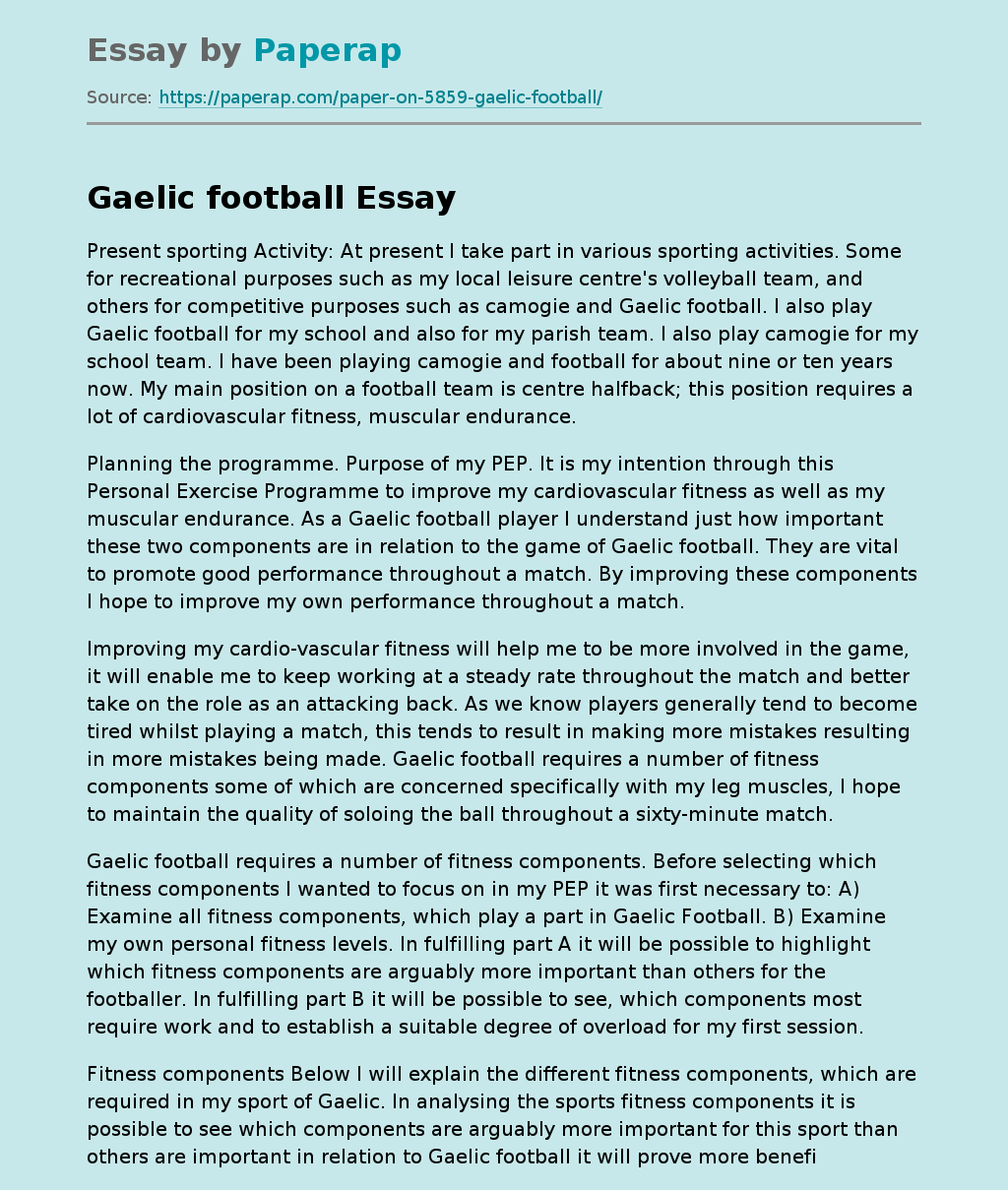Gaelic Football
Present sporting Activity: At present I take part in various sporting activities. Some for recreational purposes such as my local leisure centre’s volleyball team, and others for competitive purposes such as camogie and Gaelic football. I also play Gaelic football for my school and also for my parish team. I also play camogie for my school team. I have been playing camogie and football for about nine or ten years now. My main position on a football team is centre halfback; this position requires a lot of cardiovascular fitness, muscular endurance.
Planning the programme. Purpose of my PEP. It is my intention through this Personal Exercise Programme to improve my cardiovascular fitness as well as my muscular endurance. As a Gaelic football player I understand just how important these two components are in relation to the game of Gaelic football. They are vital to promote good performance throughout a match.
By improving these components I hope to improve my own performance throughout a match.
Improving my cardio-vascular fitness will help me to be more involved in the game, it will enable me to keep working at a steady rate throughout the match and better take on the role as an attacking back. As we know players generally tend to become tired whilst playing a match, this tends to result in making more mistakes resulting in more mistakes being made. Gaelic football requires a number of fitness components some of which are concerned specifically with my leg muscles, I hope to maintain the quality of soloing the ball throughout a sixty-minute match.
Gaelic football requires a number of fitness components. Before selecting which fitness components I wanted to focus on in my PEP it was first necessary to: A) Examine all fitness components, which play a part in Gaelic Football. B) Examine my own personal fitness levels. In fulfilling part A it will be possible to highlight which fitness components are arguably more important than others for the footballer. In fulfilling part B it will be possible to see, which components most require work and to establish a suitable degree of overload for my first session.
Fitness components Below I will explain the different fitness components, which are required in my sport of Gaelic. In analysing the sports fitness components it is possible to see which components are arguably more important for this sport than others are important in relation to Gaelic football it will prove more beneficial for me if I focus on the most important aspects of my fitness for my chosen sport. According to ‘Wesson Et Al’
Cardiovascular fitness This is the ability to provide and sustain energy aerobically. It is dependent upon the ability of the cardiovascular system to transport and utilise oxygen during sustained exercise. Increasing cardiovascular fitness means increasing the capability of the heart and the rest of the cardiovascular system in their most important task, to supply oxygen and energy to your body. Having good cardiovascular fitness has many health benefits. For example, it decreases your risk of cardiovascular diseases, stroke, high blood pressure, diabetes and other diseases. Cardiovascular fitness is best improved by activities, which employ large muscle groups working dynamically. Such activities include walking, jogging, running, swimming, skating, cycling, stair climbing and cross-country skiing.
Muscular Endurance This is the ability of a muscle or group of muscles to sustain repeated contractions against a resistance for sixty minutes. As we know a game of Gaelic football lasts about one hour. Muscular endurance is required in order to be able to withstand the pace throughout the whole game. Muscular endurance is also required for soloing, kicking and hand passing. If muscular endurance is under-developed, technique and accuracy will deteriorate.
Muscular Strength This is the maximum force that can be developed in a muscle or group of muscles during a single maximum contraction. Muscular strength is used in a football match to give distance to a kick. A high level of muscular strength can leave the legs feeling stronger and can delay effects of fatigue so that a better performance can be seen. Muscular strength is also needed when tackling opponents or indeed when being tackled.
Muscular Power Generating the maximum force (strength) in relation to time (speed). Within Gaelic football muscular power is important, as it is needed for such skills as high fielding. Flexibility This is the range of movement possible at a joint, it is determined by the elasticity of ligaments and tendons. Usually the type of joint determines the degree of movement as joints are used either for stability or mobility. Flexibility is required in the game of Gaelic football in order to the pick the ball of the ground. Flexibility in the ankle joint is also required while soloing. This is the ability to put body parts into motion quickly or to the maximum rate that a person can move over a specific distance. Speed generally tends to be determined by the physiological make-up of the muscles. In Gaelic football speed is required in order to overcome the opponent and meet the ball before ones marker.
Gaelic Football. (2017, Sep 29). Retrieved from https://paperap.com/paper-on-5859-gaelic-football/

